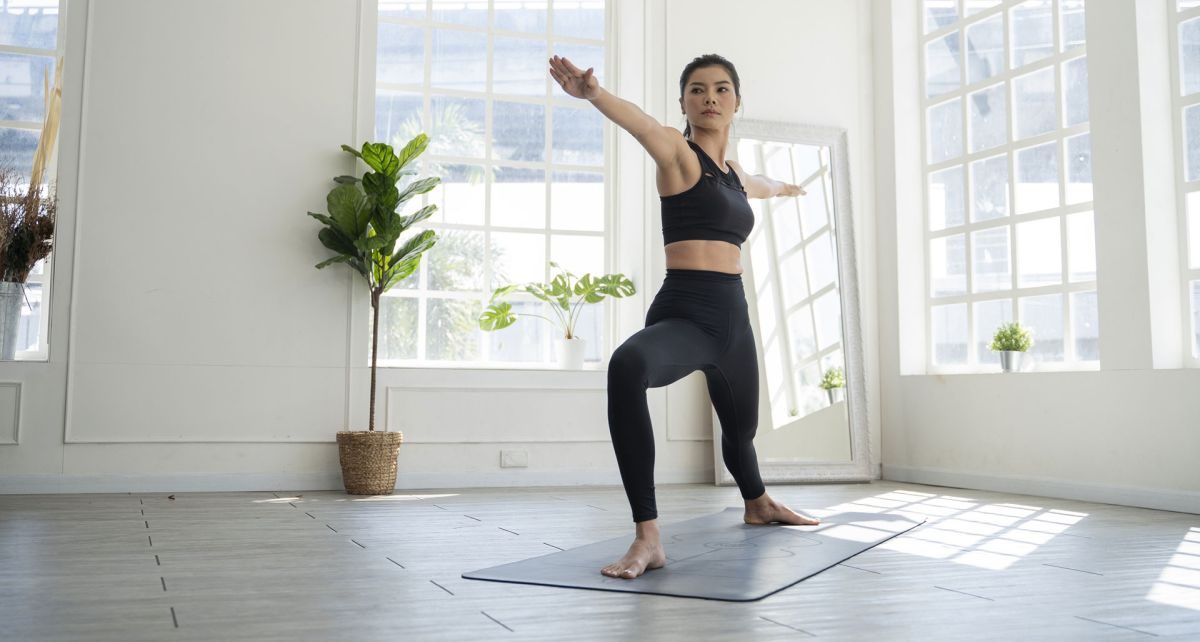More people than ever are learning how to be good at yoga, especially since the pandemic made working out at home a priority for millions during lockdown. Named by the American College of Sports Medicine as one of the top 20 worldwide fitness trends for 2021, yoga is a consistently popular and effective way to exercise. The benefits of yoga are truly remarkable, and it is widely accepted that yoga can help you lose weight, build muscle and even fix your posture.
Here, we take a look at some of the key things you need to get started, dispel common yoga myths such as that you have to be super flexible to be good at yoga, and explain how and why it’s so beneficial for your core.
Once you’re ready to start practicing, make sure you read through our round-up of the best yoga mats, where we rank popular yoga mats such as the Sweaty Betty Super Grip Yoga Mat and Lululemon 5mm Yoga Mat.
- Related: 7 types of yoga
How to be good at yoga
From Ashtanga to Bikram and Hatha yoga, there are many different types of yoga out there—each with their own benefits.
But if you’re new to this form of exercise, you might be wondering how to be good at yoga?
The first thing to do is find a class!
Most gyms and fitness centers will have yoga sessions on their timetables or you could look at attending a class at a more specialized yoga studio. Here you may find a wider choice of sessions, instructors and different types of yoga available.
The key, according to TV sports presenter and qualified yoga teacher Alexandra Legouix, is to look for a class which is suitable for beginners.
Attending an entry level class will help you get comfortable with the basics without the pressure of trying to keep up with more experienced participants or feeling intimidated by more advanced poses. If you prefer working out at home, you could also find an online yoga tutorial or use a DVD as your guide.
Yoga blocks are also good for beginners to provide support and help you work at your own level or you could try a chair yoga class for a more gentle introduction.
As Alexandra points out, you should check out the credentials of the person teaching you, as “If you are following a DVD or online class, it’s very important you choose one that is being taught by an accredited practitioner, as you are not getting the hands-on guidance which you would get in a class.”
Regular practice can lead to improvement, so it’s a good idea to commit to a few sessions per week.
Alexandra recommends three times a week “as a good way of getting into a routine, that also gives you time for rest days.”
But she believes people shouldn’t feel obligated or pressured to attend a certain number of sessions.
Instead your yoga practice should fit into your lifestyle and alongside any other fitness activities you’re participating in.
And if you’re struggling for time, a quick 10-15 minute stretching or meditation session can be a great start to the day.
- Related: When did yoga originate?
Do you have to be flexible to be good at yoga?
While the thought of yoga can conjure up images of super-flexible people in poses which may seem impossible, it’s encouraging to hear from the experts like Alexandra that you don’t have to be super bendy to enjoy the practice.
“You don’t have to be flexible to be good at yoga—that’s such a common myth. I never encourage people straightaway to try and touch the floor with their legs straight.”
Alexandra advises building up gradually and easing your way into poses; increasing blood flow and warming up your muscles makes you more comfortable in the poses and increases flexibility.
How can yoga help your core?
Yoga is very core-focused—if you don’t control your core, you won’t be able to balance correctly or stay in position.
Yoga and breathwork teacher Laura Pearce said: “There are quite a few aspects of most yoga practices that help to improve core strength.
“There is the obvious balance work that wakes up proprioceptors and helps strengthen the neurological connections that help us ‘access our core’ and there are the big abdominal moves in dynamic practices, namely the high-low plank combo of the Chaturanga Vinyasa sequence.
“There are also lots of intense oblique activating poses, such as side plank, half-moon, where you’re facing sideways with one arm and leg lifted high, the other limbs touching the floor, and let’s not forget the backbend work we do in yoga, which strengthens the lower back and glutes.”
For serious core strengthening, Laura recommended Forrest Yoga who use an opening sequence of sit-ups, as well as most Power, Rocket, Ashtanga or other very dynamic practices.
As well as physical poses, the breathwork involved in yoga is also good for strengthening the core.
She added: “What a lot of people don’t realise is that the diaphragm is one of our biggest and most important core muscles. The diaphragm stabilises the spine and connects to so many important deep set muscles, such as your Psoas.
“In most yoga practices, breathwork is a big portion of what we do. We work with cultivating a strong, mobile diaphragm through breathing and also literally engaging the diaphragms of the body in Uddiyana and Mula Bandha aka ‘tummy and root lock’. These practices are tough, and take a long time to cultivate, but have a profound effect on our deep, deep core.”
Source: Read Full Article




